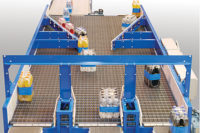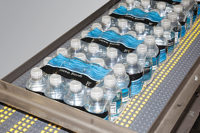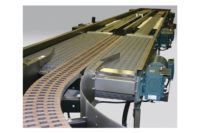Original equipment manufacturers (OEMs) have been quick to respond to increasing demands within the beverage industry by creating equipment that accommodates faster filling times, flexibility in processing, and quick handling of multiple SKUs. Some of these accommodations are possible because of enhancements to conveyors, experts note.
More specifically, the trend of SKU proliferation has demanded that conveyors run faster and be more flexible, according to Ole B. Rygh, president and chief executive officer of Ryson International Inc., Yorktown, Va.
With SKU proliferation also comes a variety of different packaging styles that conveyors need to flex to accommodate, says Scott Shannon, packaging team leader for the Americas and Asia-Pacific at Intralox LLC USA, New Orleans, La. “The biggest impact to conveyor systems is changes related to primary and secondary packaging,” he explains. To handle lightweight containers and packages with reduced secondary packaging, OEMs must design systems with gentle handling, he notes. “This requires touchless pack turning, merging, diverting, rejecting and rethinking acceptable accumulation lengths and methods,” he says.
J. Bryan Boyce, product manager of conveyor products for Mason, Ohio-based Intelligrated, says he believes that conveyor selection is highly important to be successful. “OEMs are looking at better ways to control packages on the line [through the] use of automatically adjusted side guides, using powered transitions between conveyors and advanced zone control for accumulation,” he says.
Beyond SKU proliferation, a few other trends have been impacting conveyor equipment. Customization is one, according to Intralox’s Shannon. “In the past, beverage producers provided full pallets of a homogeneous flavor,” he explains. “Now, we see requirements for custom pallets or even custom layer tiers. The customization of pallets can be done manually at the plant or local warehouse or through automated storage and retrieval systems. In either scenario, this requires depalletizing the homogeneous [pallet], sorting each flavor or pack type, and then repalletizing [the packages] in whatever custom configuration their customer requires.”
Intelligrated’s Boyce says that the reduction of packaging materials is a huge concern too. “We are seeing not just a reduction in primary packaging material, but secondary packaging is also being reduced,” he says. “A common packaging change right now is removing bottom fiber boards or trays and using shrink wrap only for the secondary packaging of PET bottles.”
Around-the-clock demand for production runs is the biggest trend of all, according to Ryson’s Rygh. “Beverage plants often run 24/7 and therefore require very reliable equipment that needs little maintenance,” he says. “There is also a considerable effort in the beverage industry to make the warehousing and order-picking operations more automated, particularly when it comes to assembling pallets of mixed products.”
These demands for productivity can be very hard on the machinery and equipment, sometimes with debilitating results, experts note.
“High speed makes preventative maintenance more critical and can shorten the life of equipment if not properly maintained,” Ryson’s Rygh says.
Intelligrated’s Boyce agrees, saying: “Obviously, the faster the conveyor runs, the harder it is to control the case, maintain case integrity, contain maintenance requirements, and promote long conveyor life. Using variable-frequency drive (VFD) controllers on all conveyor drives provides a way to set conveyor speeds at the minimum required for groups of package types or styles, or a specific package, thereby optimizing line operation.
“The cost to use VFD controllers has become justifiable to the point that they are the norm for conveyor drive control,” Boyce continues. “VFDs provide a means for setting up the line to operate at optimum speeds required for the particular product being run. Advancements in zone control technology have provided a means to customize accumulation conveyor operation, providing improved case handling as well as maximizing accumulation time and minimizing line recovery time. Advanced simulation software can be used to replicate the specific packaging line layout in order to ensure the conveyor line provides the maximum overall effective accumulation and operational requirements.”
As conveyor OEMS work to design systems that keep up with all of these demands, experts note that coordinating conveyor operation with other equipment in the system will be the key to productivity. “Conveyors, particularly post-packer, are using much more advanced control schemes,” Intelligrated’s Boyce says. “Conveyor speeds and actual operational functions, such as accumulation release methods, are being set up for each individual package type that is run on the line. We believe there will be increased emphasis on integrating the entire line operations with localized conveyor control, such as accumulation zone control, to optimize operations.”
Intralox’s Shannon agrees, adding: “There is a non-stop race from manufacturers to accelerate innovation in an effort to meet the beverage producers’ need to differentiate and meet environmental responsibility. We hear flexibility and futureproofing all the time, and this will continue to be the case.”



